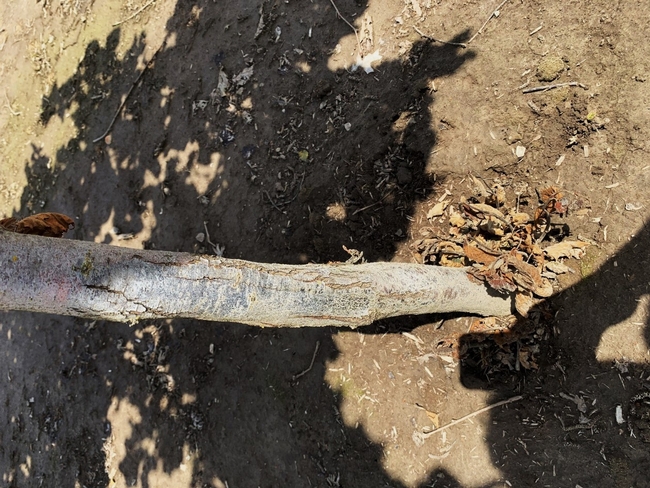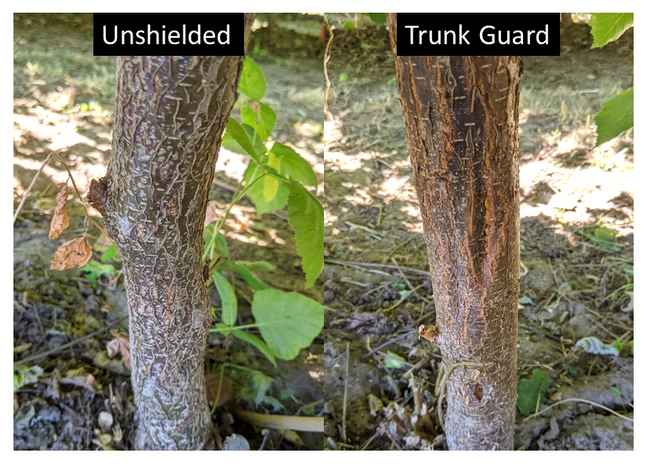
Sucker control practices place very young orchards at risk of herbicide injury, because trees from zero to three years old are more susceptible to herbicide damage (Figure 1). Trunk guards and latex paint are used to shield hazelnut trunks from sunburn, but it has remained unclear whether latex paint protects young trees from herbicide injury. Carefully weighing the pros and cons of each option must be considered before adopting either of these practices.
Many postemergence herbicides are used for sucker control in hazelnuts. We studied the effects of glufosinate (Cheetah, Forfeit 280, Reckon 280 SL, Rely 280, and others) on layer-propagated ‘Jefferson' hazelnuts 0, 1, and 2 years after planting to understand how to better protect young trees from herbicide injury. While the activity of other herbicides can also induce trunk damage, we focused on glufosinate alone to determine its potential for young hazelnut injury from this commonly used herbicide. Tree trunks were unshielded, painted, or shielded by an opaque plastic trunk guard (Figure 2). Trunks were painted once or had trunk guards installed at planting. In addition, we studied the effect of herbicide rate and the number of applications. We applied glufosinate at the label (56 fl oz/acre, 1x), at double the legal label rate (2x), or at quadruple the legal label rate (4x). Each rate was applied one, two, or three times per season. All treatments were repeated the following year. Trees were cut down to evaluate any damage to the tree cambium in the third year. We included off-label rates (2x, 4x) to compare the effect of trunk protection.
In our trials, the 1x label rate stunted the growth of newly planted trees (<1 year-old). We expected this negative response as the label warns against treating plants less than one year old with glufosinate. As the trees matured, they tolerated higher application rates; one-year-old trees suffered trunk injury only at the 4x legal label rate. Trunk injury as applications increased from one to three times per year only occurred at applications above the label rate, suggesting that herbicide rate is more important than the number of applications. At any age, no trunk damage was observed at the label rate. This finding underscores the importance of proper sprayer calibration to deliver the correct herbicide rate and reduce trunk damage.
The bark confers protection.
An additional treatment was included where the bark was scraped prior to herbicide application at the 1x rate. The newly planted trees (<1-year old) all died when subjected to this treatment and injury was detected consistently at older ages as well. This was the only instance when the injury was detected when following the herbicide label, suggesting that bark integrity is essential to the prevention of herbicide injury.
Latex paint.
Latex paint effectively protects trees of any age. Paint reduced stunting in newly planted trees compared to unshielded trees at the 1x and 2x legal label rates. Painted trees survived the 4x legal label rates (85%) more than unshielded trees (41%). Across all ages painted trees were 12% greater in trunk cross-sectional area than unshielded trees. Latex paint halved the injury of 1- and 2-year-old trees, when measuring external and internal injury (Figure 3). Tree injuries were photographed one year after the final herbicide exposure.
A tree can recover from trunk injury and produce for many years. Still, injury affecting trunk heartwood and pith can leave a tree structurally unsound and may reduce its longevity.
Trunk guards.
On average, trees with painted trunks were 12% larger than trees with unshielded trunks, but trees with trunk guards surpassed the growth of painted trees by a further 10%. The trunk guard prevented any herbicide injury to trees.
In our study, hazelnut trees grew well in trunk guards, although concerns have been raised about the quality of the wood and bark following trunk guard use. Wood density was reduced in our trunk guard treatment compared to the unshielded and painted trees. We cannot predict whether reduced wood density will recover as the trees mature. In general, greater wood density indicates stronger wood.
Removing trunk guards.
Bark grown under trunk guards may be more sensitive to sunburn and herbicide injury when the guard is eventually removed, compared to painted or unshielded trees. In the fourth year of this study, we removed the trunk guards. Herbicide applications after the trunk guard removal doubled the injured surface area compared to trees that were grown with unshielded trees (Figure 4). The depth of these injuries was not doubled, however, likely due to the increased size of the trees. Herbicide injury following the removal of trunk guards only occurred at high rates (2x or 4x legal label rates).
Our results clarify the role of trunk protection in protecting young hazelnut trees from herbicide injury. Following label recommendations and proper sprayer calibration are important factors in reducing herbicide injury to tree trunks. In this study, 1- and 2-year-old trees were injured only when off-label rates were applied to them. Older trees are more tolerant of herbicide as a sucker control strategy.
Trunk guards and latex paint effectively protected young hazelnut trees from herbicide injury and increased tree trunk growth. The reduced wood density and increased bark sensitivity resulting from trunk guard use may reduce their use in young hazelnut plantings, but their benefits cannot be ignored. Latex paint is a promising alternative to trunk guards and effectively reduces herbicide injury and encourages growth in all cases observed.
DISCLAIMER: The information contained in this article is for experimental purposes only. You must not rely upon the material as a basis for making a pesticide recommendation. Follow the label instructions!
We thank the Oregon Hazelnut Commission, Christensen Farms, Birkemeir Nursery, and OO Agriculture for collaborating and providing financial support to this project.
Ryan Hill and Marcelo Moretti are with the Department of Horticulture at Oregon State University.
Original source: Weeders of the West blog :: Jan. 26, 2023


